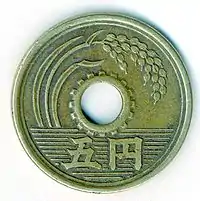Banknotes of the Japanese yen
The banknotes of the Japanese yen are part of the physical form of Japan's currency. Modern banknotes were first released by the Bank of Japan in 1885, three years after the Japanese government established a centralized bank. Throughout their history, the denominations have ranged from 0.05 yen to 10,000 yen. Only banknotes issued by the Bank of Japan are included here.
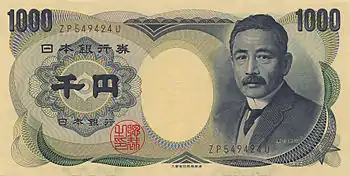
Meiji era
1885–1887
| Daikokuten (1885–87) | ||||||||
|---|---|---|---|---|---|---|---|---|
| Image | Value | Dimensions | Description | Date of | ||||
| Obverse | Reverse | Obverse | Reverse | Issue | Issue suspension | Expiration | ||
 |
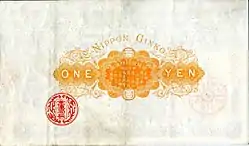 |
¥1 | 78 X 135 mm | Daikokuten | Geometric patterns | September 8, 1885 | October 1, 1958 | Valid |
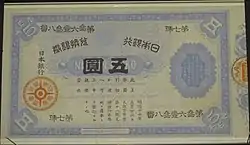 |
N/A | ¥5 | 87 × 152 mm | Geometric patterns | Daikokuten | January 4, 1886 | N/A | March 31, 1939 |
| N/A | N/A | ¥10 | 93 × 156 mm | Daikokuten | Geometric patterns | May 9, 1887 | N/A | March 31, 1945 |
| N/A | N/A | ¥100 | 116 × 186 mm | Daikokuten | September 8, 1887 | N/A | ||
1888–1891
| Remodeled convertible banknotes (1888–91) | ||||||||
|---|---|---|---|---|---|---|---|---|
| Image | Value | Dimensions | Description | Date of | ||||
| Obverse | Reverse | Obverse | Reverse | Issue | Issue suspension | Expiration | ||
| N/A |  |
¥1 | 85 X 145 mm | Takenouchi no Sukune | Silver obligation | May 1, 1889 | October 1, 1958 | Valid |
 |
N/A | ¥5 | 95 X 159 mm | Sugawara no Michizane | Silver obligation | December 3, 1888 | N/A | March 31, 1939 |
 |
N/A | ¥10 | 100 X 169 mm | Wake no Kiyomaro | Silver obligation | September 12, 1890 | N/A | March 31, 1925 |
 |
N/A | ¥100 | 130 X 210 mm | Fujiwara no Kamatari | Silver obligation | November 15, 1891 | N/A | March 31, 1945 |
1899–1900
| Convertible Banknote A (1899–1900) | ||||||||
|---|---|---|---|---|---|---|---|---|
| Image | Value | Dimensions | Description | Date of | ||||
| Obverse | Reverse | Obverse | Reverse | Issue | Issue suspension | Expiration | ||
 |
N/A | ¥5 | 85 X 146 mm | Takenouchi no Sukune and Ube Shrine | Gold obligation | April 1, 1899 | N/A | March 31, 1939 |
 |
 |
¥10 | 96 X 159 mm | Wake no Kiyomaro and Goou shrine | Wild Boar design with gold obligation | October 1, 1899 | N/A | March 31, 1939 |
 |
N/A | ¥100 | 130 X 210 mm | Fujiwara no Kamatari and Tanzan Shrine | Gold obligation | 1900 | 1913 | March 31, 1939 |
1910
| Convertible Banknote B (1910) | ||||||||
|---|---|---|---|---|---|---|---|---|
| Image | Value | Dimensions | Description | Date of | ||||
| Obverse | Reverse | Obverse | Reverse | Issue | Issue suspension | Expiration | ||
 |
N/A | ¥5 | 78 X 136 mm | Sugawara no Michizane | Kitano Tenmangū shrine with convertible wording | September 1, 1910 | N/A | March 31, 1939 |
Taishō era
1915–1917
| Taishō convertible banknotes (1915–17) | ||||||||
|---|---|---|---|---|---|---|---|---|
| Image | Value | Dimensions | Description | Date of | ||||
| Obverse | Reverse | Obverse | Reverse | Issue | Issue suspension | Expiration | ||
 |
 |
¥1 | 85 X 145 mm | Takenouchi no Sukune | Silver obligation | August 15, 1916 | October 1, 1958 | Valid |
| N/A | N/A | ¥5 | 73 X 130 mm | Takenouchi no Sukune and Ube shrine | Convertible wording | December 15, 1916 | February, 1927 | March 31, 1939 |
 |
N/A | ¥10 | 89 X 139 mm | Wake no Kiyomaro and Goou shrine | Convertible wording | May 1, 1915 | N/A | March 31, 1939 |
 |
N/A | ¥20 | 86 X 149 mm | Sugawara no Michizane | Kitano Tenmangu shrine | November 20, 1917 | N/A | March 31, 1939 |
Shōwa era
1946–1948
| Series A (1946–48) | ||||||||
|---|---|---|---|---|---|---|---|---|
| Image | Value | Dimensions | Description | Date of | ||||
| Obverse | Reverse | Obverse | Reverse | Issue | Issue suspension | Expiration | ||
| ¥0.05 | 94 × 48 mm | Prunus mume blossoms | Geometric patterns | May 25, 1948 | December 31, 1953 | June 30, 1954 | ||
| ¥0.1 | 100 × 52 mm | Pigeons | The Diet building | September 5, 1947 | ||||
| ¥1 | 124 × 68 mm | Ninomiya Sontoku | Geometric patterns | March 19, 1946 | October 1, 1958 | Valid | ||
| ¥5 | 132 × 68 mm | Geometric patterns | March 5, 1946 | April 1, 1955 | ||||
 |
 |
¥10 | 140 × 76 mm | The Diet building | February 25, 1946 | |||
 |
 |
¥100 | 162 × 93 mm | Prince Shōtoku, "Yumedono" (A hall associated with Prince Shōtoku in Hōryū-ji Temple) | Hōryū-ji Temple | February 25, 1946 | July 5, 1956 | |
| For table standards, see the banknote specification table. | ||||||||
1950–1953
| Series B (1950–53) [1] | ||||||||
|---|---|---|---|---|---|---|---|---|
| Image | Value | Dimensions | Main Color | Description | Date of | |||
| Obverse | Reverse | Obverse | Reverse | Issue | Issue suspension | |||
| ¥50 | 144 × 68 mm | Orange | Takahashi Korekiyo | The headquarters of the Bank of Japan | December 1, 1951 | October 1, 1958 | ||
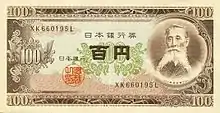 |
 |
¥100 | 148 × 76 mm | Brown-orange | Itagaki Taisuke | The Diet building | December 1, 1953 | August 1, 1974 |
 |
 |
¥500 | 156 × 76 mm | Dark blue | Iwakura Tomomi | Mount Fuji | April 2, 1951 | January 4, 1971 |
 |
 |
¥1000 | 164 × 76 mm | Grey | Prince Shōtoku | "Yumedono" | January 7, 1950 | January 4, 1965 |
| For table standards, see the banknote specification table. | ||||||||
Series B introduced a new high value banknote ¥1000.
1957–1969
| Series C (1957–69) [1] | ||||||||
|---|---|---|---|---|---|---|---|---|
| Image | Value | Dimensions | Main Color | Description | Date of | |||
| Obverse | Reverse | Obverse | Reverse | Issue | Issue suspension | |||
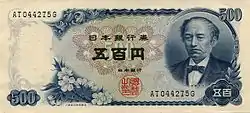 |
 |
¥500 | 159 × 72 mm | Blue | Iwakura Tomomi | Mount Fuji | November 1, 1969 | April 1, 1994 |
 |
 |
¥1000 | 164 × 76 mm | Yellow-green | Itō Hirobumi | The headquarters of the Bank of Japan | November 1, 1963 | January 4, 1986 |
 |
 |
¥5000 | 169 × 80 mm | Green-brown | Prince Shōtoku | The headquarters of the Bank of Japan | October 1, 1957 | January 4, 1986 |
_front.jpg.webp) |
_back.jpg.webp) |
¥10,000 | 174 × 84 mm | Brown-green | Prince Shōtoku | A pillar painting of Hōō in Byōdō-in Temple | December 1, 1958 | January 4, 1986 |
| For table standards, see the banknote specification table. | ||||||||
The series C introduced two new high value banknotes ¥5000 and ¥10,000.
1984
| Series D (1984) [2] | ||||||||
|---|---|---|---|---|---|---|---|---|
| Image | Value | Dimensions | Main Color | Description | Date of | |||
| Obverse | Reverse | Obverse | Reverse | Issue | Issue suspension | |||
 |
 |
¥1000 | 150 × 76 mm | Blue | Natsume Sōseki | Pair of cranes | November 1, 1984 | April 2, 2007 |
 |
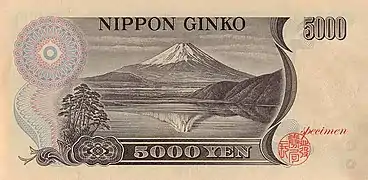 |
¥5000 | 155 × 76 mm | Purple | Nitobe Inazō | Mount Fuji, Lake Motosu | ||
 |
 |
¥10,000 | 160 × 76 mm | Brown | Fukuzawa Yukichi | Pair of pheasants | ||
| For table standards, see the banknote specification table. | ||||||||
Due to the discovery of a large number of counterfeit Series D banknotes at the end of 2004, all Series D banknotes except ¥2000 were virtually suspended on January 17, 2005,[3] and officially suspended on April 2, 2007.[4] According to a news release [5] from the National Police Agency, they seized 11,717 counterfeit Series D banknotes (excluding the ¥2000 denomination) in 2005. However, they seized only 486 counterfeit current issue banknotes, namely Series E ¥1000, ¥5000, ¥10,000, and Series D ¥2000.
Heisei era
2000
| Series D (2000) [2] | |||||||
|---|---|---|---|---|---|---|---|
| Image | Value | Dimensions | Main Color | Description | Date of issue | ||
| Obverse | Reverse | Obverse | Reverse | ||||
_front.jpg.webp) |
 |
¥2000 | 154 × 76 mm | Green | Shurei-mon | Scene from the Tale of Genji and portrait of Murasaki Shikibu | July 19, 2000 |
| For table standards, see the banknote specification table. | |||||||

This is the current issue. The 2000 yen note was first issued on July 19, 2000 to commemorate the 26th G8 summit in Okinawa and the 2000 millennium year as well. Pictured on the front of the note is Shureimon, a famous gate in Naha, Okinawa near the site of the summit. The other side features a scene from The Tale of Genji and the author Murasaki Shikibu on the lower right corner. The motif of the scene was taken from the 12th century illuminated handscrolls of the novel kept at the Tokugawa Art Museum in Nagoya. The image of Murasaki Shikibu is taken from the Gotoh edition of the Murasaki Shikibu Diary Emaki held at the Gotoh Museum.
These notes are rare in the market, but at banks they are readily available. Many Japanese consider the 2000 yen note a novelty as it is the only Japanese denomination whose first digit is 2. To promote the circulation of the notes, some companies had started paying wages in them. The series D is the first to display the EURion constellation.
2004
| Series E (2004) [2] | |||||||
|---|---|---|---|---|---|---|---|
| Image | Value | Dimensions | Main Color | Description | Date of issue | ||
| Obverse | Reverse | Obverse | Reverse | ||||
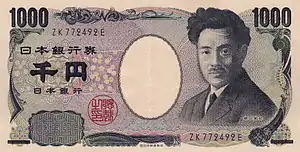 |
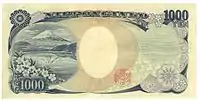 |
¥1000 | 150 × 76 mm | Blue | Noguchi Hideyo | Mount Fuji, Lake Motosu and cherry blossoms | November 1, 2004 |
 |
 |
¥5000 | 156 × 76 mm | Purple | Higuchi Ichiyō | Kakitsubata-zu (Painting of irises, a work by Ogata Kōrin) | |
 |
 |
¥10,000 | 160 × 76 mm | Brown | Fukuzawa Yukichi | Statue of hōō (phoenix) from Byōdō-in Temple | |
| For table standards, see the banknote specification table. | |||||||
This is the current issue. The EURion constellation pattern can be observed on the series E.
Reiwa era
2024
On April 9, 2019, Finance Minister Tarō Asō announced new designs for the ¥1000, ¥5000, and ¥10,000 notes, for use beginning in 2024.[6] The ¥1000 bill will feature Kitasato Shibasaburō and The Great Wave off Kanagawa, the ¥5000 bill will feature Tsuda Umeko and wisteria flowers, and the ¥10,000 bill will feature Shibusawa Eiichi and Tokyo Station.
| Series F (2024, scheduled) | |||||||
|---|---|---|---|---|---|---|---|
| Image | Value | Dimensions | Main Color | Description | Date of issue | ||
| Obverse | Reverse | Obverse | Reverse | ||||
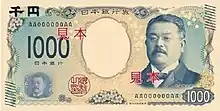 |
 |
¥1000 | 150 × 76 mm | Blue | Kitasato Shibasaburō | The Great Wave off Kanagawa (from Thirty-six Views of Mount Fuji series by Hokusai) | 2024, scheduled |
 |
 |
¥5000 | 156 × 76 mm | Purple | Tsuda Umeko | wisteria flowers | |
 |
 |
¥10,000 | 160 × 76 mm | Brown | Shibusawa Eiichi | Tokyo Station (Marunouchi side) | |
| For table standards, see the banknote specification table. | |||||||
References
- "Archived copy" (PDF). Archived from the original (PDF) on March 25, 2009. Retrieved April 27, 2008.
{{cite web}}: CS1 maint: archived copy as title (link) - Currency in Use: Bank of Japan Archived 2007-08-18 at the Wayback Machine
- http://www.boj.or.jp/type/release/zuiji/bnnew16.htm Archived August 8, 2007, at the Wayback Machine
- 一万円券、五千円券および千円券の今後の支払について:日本銀行 Archived September 29, 2007, at the Wayback Machine
- http://www.npa.go.jp/toukei/souni/gizou.htm Archived August 10, 2007, at the Wayback Machine
- "Japan announces new ¥10,000, ¥5,000 and ¥1,000 bank notes as Reiwa Era looms". Japan Times. Retrieved April 9, 2019.
External links
| Wikimedia Commons has media related to Money of Japan. |
